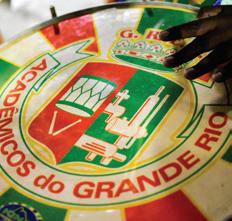
20 minute read
Grande Rio
2ª colocada |
2nd placed GRES Acadêmicos do Grande Rio
Advertisement
5ª Escola - Entre 1h30 e 2h10 5th School - Between 1:30am and 2:10am
Concentração: Correios | Meeting Point: Post Office
Sinopse do Enredo | Samba Theme Synopsis
A agremiação de Caxias contará a história de Joãozinho da Gomeia, pai de santo que nasceu na Bahia e fez história como um dos mais famosos líderes religiosos do Brasil. Negro e homossexual, superou as barreiras do preconceito e em seu terreiro em Duque de Caxias, atendeu milhares de pessoas, incluindo grandes nomes da política e do mundo artístico. Grande Rio samba school will tell the story of Joãozinho da Gomeia, a spiritual leader who was born in Bahia and made history as one of the most famous leaders of Afro-Brazilian religions in Brazil. Black and homosexual, Joãozinho overcame the barriers of prejudice and helped thousands of people in his sacred yard in Duque de Caxias, including great names in national politics and in the artistic world.
Cante com a Grande Rio
Sing along with Grande Rio
ENREDO: TATALONDIRÁ. O CANTO DO CABOCLO NO QUILOMBO DE CAXIAS THEME: TATALONDIRÁ. THE INDIAN ENTITY’S SONG IN THE CAXIAS’ REFUGE
Compositores | Songwriters: Derê, Robson Moratelli, Rafael Ribeiro e/and Toni Vietnã. Intérprete | Singer: Evandro Malandro
É PEDRA PRETA! QUEM RISCA PONTO NESTA CASA DE CABOCLO CHAMA FLECHEIRO, LÍRIO E ARRANCA-TOCO SEU “SERRA NEGRA” NA JUREMA, JUREMÁ…
PEDRA PRETA! O ASSENTAMENTO FICA AO PÉ DO DENDEZEIRO NA CAPA DE EXU, CAMINHO INTEIRO EM CADA ENCRUZILHADA UM ALGUIDAR ERA HOMEM, ERA BICHO-FLOR BICHO-HOMEM, PENA DE PAVÃO A VISÃO QUE PARECIA DOR AVISANDO SALVADOR, JOÃO! NO CAMUTUÊ JUBIABÁ LÁ NA ROÇA A GAMELEIRA “DA GOMEIA” DAVA O QUE FALAR NA CURIMBA FEITICEIRA
OKÊ! OKÊ! OXÓSSI É CAÇADOR OKÊ! ARÔ! ODÉ! NA PAZ DE ZAMBI, ELE É MUTALAMBÔ! O ALAKETO, GUARDIÃO DO AGUERÉ
É ISSO, DENDÊ E CATIÇO O RITO MESTIÇO QUE SAI DA BAHIA E LEVA MEU PAI MANDINGUEIRO BAIXAR NO TERREIRO QUILOMBO CAXIAS MALANDRO, VEDETE, HERÓI, FARAÓ… UM SARAVÁ PRA FOLIA BAILAM OS SEUS PÉS E PELO AR O BENJOIM GIRAM PRESIDENTES, PENITENTES, YABÁS CURVA-SE A RAINHA E OS OGANS BATUQUEIROS PEDEM PAZ
SALVE O CANDOMBLÉ, EPARREI OYÁ GRANDE RIO É TATALONDIRÁ PELO AMOR DE DEUS, PELO AMOR QUE HÁ NA FÉ EU RESPEITO SEU AMÉM VOCÊ RESPEITA O MEU AXÉ
(RESPEITA O MEU AXÉ)
© Copyright: Editora Musical Escola de Samba Ltda.
Acompanhe o Desfi le | Parade Sequence
COMISSÃO DE FRENTE | HONORARY COMMITTEE FANTASIA: PONTO RISCADO COSTUME: SACRED DIAGRAM OF ORISHAS COREÓGRAFO | CHOREOGRAPHER: HÉLIO BEJANI E/AND BETH BEJANI O Ponto riscado sintetiza o “rito mestiço” do Candomblé de Caboclo. Joãozinho da Gomeia, Pai de Santo baiano, praticava o rito mestiço diversifi cando o culto a orixás (tradição Ketu), inquices (tradição Angola) e caboclos. | “Ponto riscado” is a synthesis of the mestizo rite of Caboclo Candomblé. Joãozinho da Gomeia, a Bahian “Pai de Santo” (spiritual leader), practiced the mestizo rite and diversifi ed the cult to the Orishas mixing Ketu and Angolan Candomblé with Caboclos (Indian spiritual entities venerated in Brazil).
GUARDIÕES DO 1º CASAL DE MESTRE-SALA E PORTA-BANDEIRA | GUARDIANS OF THE 1ST COUPLE
FANTASIA: SERVOS DE EXU COSTUME: SERVANTS OF ESÚ Os guardiões evocam a energia de Exu, instauradora de todo axé; oferta de alguidares com a farofa sagrada, o padê. | The guardians evoke the energy of Esú - an Afro-Brazilian entity who is known as the instigator of all spiritual energy (axé). They offer bowls with the sacred fl our, the “padê”.
1º CASAL DE MESTRE-SALA E PORTA-BANDEIRA 1ST MASTER-OF-CEREMONIES-AND-FLAG
BEARER COUPLE: DANIEL WERNECK E/AND TACIANA COUTO FANTASIA: PADÊ DE EXU LIBERTADOR COSTUME: THE ESÚ-LIBERATOR’S FLOUR O casal reverencia Exu, com fi gurinos que dialogam com poema de Abdias Nascimento, mesclando elementos de Exu-Bara e Exu-Catiço, minucioso trabalho em búzios e miçangas. | The couple reveres Esú, with costumes that dialogue with a poem by Abdias Nascimento. It is a meticulous work in shells and beads that mixes elements from “Exu-Bara” and “Exu-Catiço” – different types of Esú. 1ª ALA: NOITES DE INHAMBUPE 1ST WING: NIGHTS IN INHAMBUPE Visões infantis de medo da noite de João Alves Torres Filho (nome de Joãozinho da Gomeia), com elementos e símbolos da cultura popular; as máscaras são releituras de peças angolanas do povo Yaka. | Children’s visions of fear of João Alves Torres Filho’s (name of Joãozinho da Gomeia) night, with elements and symbols of popular culture; the masks are reinterpretations of Angolan pieces from the Yaka people.
DESTAQUE DE CHÃO | FLOOR SPOT: MONIQUE ALFRADIQUE FANTASIA: CORES DA NOITE COSTUME: COLORS OF THE NIGHT A fantasia mistura as cores do arrebol para expressar as visões noturnas do menino João, no interior da Bahia. | The costume mixes the colors of the afterglow to express the night vision of boyJoão in the countryside of Bahia.
1º CARRO – ABRE-ALAS: RAÍZES ANCESTRAIS OPENING FLOAT: ANCESTRAL ROOTS O carro evoca as raízes ancestrais afro-ameríndias do homenageado, João Alves Torres Filho, o Joãozinho da Gomeia, que das redes onde dormia via as aparições noturnas. | The fl oat evokes the Afro-Amerindian ancestral roots of the honoree, João Alves Torres Filho, Joãozinho da Gomeia. From the hammocks where he slept in, he saw nocturnal apparitions.
2ª ALA: NOS PASSOS DO CONSELHEIRO 2ND WING: FOLLOWING THE COUNSELOUR’S FOOTSTEPS Joãozinho seguiu em direção a Salvador, aos 14 anos, em lombo de burro, inspirado em Antônio Conselheiro. | Joãozinho headed towards Salvador (Capital of the Bahia State), at the age of 14, on a donkey back, inspired by Antônio Conselheiro.
3ª ALA: AS GENTES DO VELHO MERCADO 3RD WING: THE PEOPLE OF THE OLD MARKET Em Salvador, João se depara com os múltiplos brasis da “Cidade da Bahia”. Lá, ele conhece sua “Madrinha”, a pessoa quem o inicia no candomblé de Angola. | In Salvador, João faces multiple types of Brazil. There, he meets his godmother, the one who initiates him in the Angolan Candomblé.
DESTAQUE DE CHÃO | FLOOR SPOT: ANTÔNIA FONTENELLE FANTASIA: QUEM NÃO VAI NO BONFIM? COSTUME: EVERYONE VISITS THE BONFIM CHURCH Em Salvador, as manifestações populares se misturam e é na igreja do Bonfi m que essa mistura fi ca mais evidente. | In Salvador, popular manifestations are mixed togetherand it is in the church of Bonfi m that this mixture is most evident.
4ª ALA: ALTARES DA CIDADE DA BAHIA 4TH WING: THE ALTARS OF THE CITY OF BAHIAN Diz a lenda que a cidade de Salvador tem 365 igrejas, uma para cada dia do ano. A igreja do santo mais popular é a do Senhor do Bonfi m. | Legend has it that the city of Salvador has 365 churches, one for each day of the year. The most popular church is the one of Senhor do Bonfi m.
5ª ALA: FESTA DO DOIS DE JULHO 5TH WING: THE JULY, 2 nd PARTY Ocorre em homenagem à Independência da Bahia. João da Gomeia era um grande entusiasta desses festejos. | The “Dois de Julho (July, 2 nd ) Festival” takes place in honor of the Independence of Bahia. João da Gomeia was a great enthusiast of these celebrations.
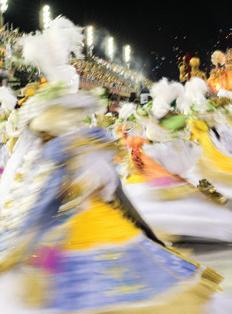
6ª ALA: IAÔS | 6TH WING: ÍYÀWÓS (THE INITIATED FOLLOWERS OF CANDOMBLÉ) Joãozinho da Gomeia sentia fortes dores de cabeça. Para fazê-las cessar, João foi iniciado no Candomblé, tendo sido consagrado a Oxóssi (inquice Mutalambô) e apresentado à comunidade religiosa com o nome iniciático de Tata Londirá. Joãozinho da Gomeia had strong headaches. To make them stop, he was initiated in Candomblé. He was, then, consecrated to Oshosi - a Ketu Orisha associated with the Nkisi Mutalambô in the Angolan Candomblé – and introduced to the community as Tata Londirá.
TRIPÉ: OKÊ OKÊ | TRIPOD: OSHOSI GREETING Reverência a Oxóssi e Mutalambô. Trata-se de uma adaptação da obra “Okê Oxóssi”, pertencente ao acervo do Museu de Arte de São Paulo – MASP. Reverence for Oxóssi and Mutalambô. It is an adaptation of the work “Okê Oxóssi”, belonging to the collection of the São Paulo Museum of Art - MASP.
7ª ALA: FESTA NA GOMEIA 7TH WING: PARTY IN GOMEIA (BAIANAS | WHIRLING LADIES) Já conhecido como “João da Pedra Preta” antes mesmo de completar 20 anos de idade, Tata Londirá dá início ao seu próprio Candomblé na roça da Gomeia na Bahia. | Already known as “João da Pedra Preta” even before turning 20 years old, Tata Londirá starts his own Candomblé in the Gomeia ranch, Bahia.
DESTAQUE DE CHÃO | FLOOR SPOT: JULIANE TREVISOL FANTASIA: CAMINHOS DO AXÉ COSTUME: WALKS OF AXE A fantasia expressa o mágico rito praticado pelos candomblés. | The costume expresses the magical rite practiced in Candomblés.
2º CARRO: XIRÊ: FOI NA ROÇA DA GOMEIA, AOS PÉS DE UMA GAMELEIRA... 2ND FLOAT: XIRÊ: IT WAS IN THE GOMEIA RANCH, AT THE FOOT OF A GAMELEIRA-TREE Trata-se da representação de um xirê (bailado festivo de orixás) no terreiro da Gomeia. | It is the representation of a “xirê” (festive ritualistic dance to invoke the Orishas) in the Gomeia sacred yard.
8 ª ALA: NAVEGAÇÃO DE CABOTAGEM 8TH WING: COASTAL NAVIGATION Diversos motivos levaram João da Gomeia a se transferir para o Rio de Janeiro: principalmente, a pressão dos candomblés matriarcais e o testemunho de artistas e intelectuais que o fez famoso. | Several reasons led João da Gomeia to move to Rio de Janeiro: mainly, the pressure of matriarchal Candomblés and the testimony of artists and intellectuals that made him famous.
9ª ALA: FEIRA DE CAXIAS 9THWING: CAXIAS FAIR Protegido das perseguições, podendo espalhar seu axé, João fez em Duque de Caxias, a “Nova Gomeia”. | Protected from persecution and able to spread his beliefs and spiritual energy, João made the “New Gomeia” in Duque de Caxias.
DESTAQUE DE CHÃO | FLOOR SPOT: RENATA KUERTEN FANTASIA: FOLHAS DE OSSAIM, ERVAS DE KATENDÊ COSTUME: OSANYIN’S LEAVES, KATENDÊ HERBS Traduz o verdejante poder das ervas, comercializadas na Feira de Caxias, onde até hoje é vendido todo produto necessário para os rituais do Candomblé. Translates the green power of herbs sold at Feira de Caxias (Caxias Fair), where until today, all products needed for Candomblé rituals are sold.
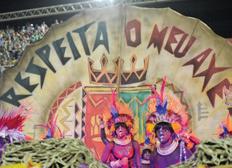
10ª ALA: CABOCLO JAGUARÁ (TERRA) | 10TH WING: THE INDIGENOUS ENTITY JAGUARÁ (EARTH) A maior inovação de João da Gomeia no seu terreiro de Caxias foi o culto aos caboclos e à Jurema sagrada. | João da Gomeia’s greatest innovation in his sacred yard in Caxias was the cult of Caboclos and the sacred Jurema.
11ª ALA: CABOCLO TAPEROÁ (FOGO) | 11TH WING: THE INDIGENOUS ENTITY TAPEROÁ (FIRE) Taperoá é apresentado segurando um girassol. Taperoá is presented holding a sunfl ower.
12ª ALA: CABOCLO VENTANIA (AR) 12TH WING: THE INDIGENOUS ENTITY GALE (AIR) Sua imagem aparece segurando pássaros. His image is holding birds.
13ª ALA: CABOCLA JUREMA (ÁGUA) | 13TH WING: THE INDIGENOUS ENTITY GALE (WATER) A Cabocla Jurema, entidade do panteão afroameríndio brasileiro, é uma tríade: cabocla, bebida ritual de efeitos alucinógenos e conjunto de reinos encantados. | Cabocla Jurema, according to the Brazilian Afro-Amerindian beliefs, is a triad: an entity, a ritual drink with hallucinogenic effects and a set of enchanted kingdoms.
DESTAQUE DE CHÃO | FLOOR SPOT: MILEIDE MIHAILE FANTASIA: ESPÍRITO DE JUPIARA COSTUME: JUPIARA´S SPIRIT A fantasia exalta a cabocla Jupiara, senhora das plantas e das águas. | The costume exalts the Jupiara entity, lady of plants and waters.
3º CARRO: QUANDO BAIXAM OS CABOCLOS NA BAIXADA | 3RD FLOAT: WHEN THE ENTITIES COME OVER O início de uma festa de caboclos na Gomeia de Caxias, quando o terreiro se transformava em bela aldeia indígena. | The beginning of a party in Gomeia de Caxias, when the terreiro turned into a beautiful indigenous village.
14ª ALA: VEDETES | 14TH WING: BRAZILIAN DANCING AND ACTING STARS Remete ao concurso de fantasias em que Joãozinho da Gomeia usou roupa em homenagem às vedetes do Teatro de Revista. | It refers to the costume contest in which Joãozinho da Gomeia wore clothes in honor of the Brazilian star actresses of the time.
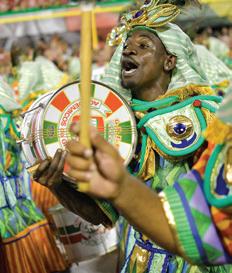
GUARDIÕES DO 2º CASAL DE MESTRE-SALA E PORTA-BANDEIRA | GUARDIANS OF THE COUPLE
FANTASIA: ARROBOBOI COSTUME: OSHUMARE GREETING Retratam Oxumarê, entidade representada pelo arco-íris e cultuada por João da Gomeia. | Portray the orisha-Oshumare, an entity represented by the rainbow and dearly worshiped by João da Gomeia.
2º CASAL DE MESTRE-SALA E PORTA-BANDEIRA 2ND MASTER-OF- CEREMONIES-AND-FLAG
BEARER COUPLE: ANDREY RICARDO E/AND JÉSSICA BARRETO FANTASIA: COMPANHIA DE OXUMARÉ, ENERGIA DE ANGORÔ | COSTUME: OSHUMARE’S COMPANY, ENERGY OF ANGORÔ (THE RAINBOW) O casal celebra a diversidade religiosa e sexual, defendendo a liberdade em suas múltiplas dimensões – aquilo que João da Gomeia representava ao encarnar a vedete. | The couple celebrates religious and sexual diversity, defending freedom in its multiple dimensions – it was what João da Gomeia represented while incarnating the star actresses of the time.
DESTAQUE DE CHÃO | FLOOR SPOT: NATÁLIA KNAACK FANTASIA: FOLIES BERGÈRE | COSTUME: FOLIES BERGÈRE, A PARISIAN CABARET Evoca o imaginário luxuoso das vedetes francesas que se apresentavam nos cabarés parisienses – universo que fascinava João. | Evokes the luxurious imagery of the French stars that performed in Parisian cabarets - a universe that fascinated João. TRIPÉ: PAVÃO DOURADO TRIPOD: GOLDEN PEACOCK A Grande Rio celebra a diversidade e o amor. A fi gura do pavão expressa a complexidade do homenageado: Joãozinho da Gomeia, Pai de Santo negro e homossexual. | Grande Rio Samba School celebrates diversity and love. The fi gure of the peacock expresses the complexity of the honoree: Joãozinho da Gomeia, a black spiritual leader and a homosexual.
15ª ALA: VULCANO | 15TH WING: VULCAN Remete à noite de 13 de fevereiro de 1960, quando João da Gomeia se fantasiou de Vulcano, o mitológico deus do fogo. | It refers to the night of February 13, 1960, when João da Gomeia dressed up as Vulcan, the mythological God of fi re.
16ª ALA: CORTE DE NETUNO 16TH WING: THE COURT OF NEPTUNE (PASSISTAS | SAMBA DANCERS) A ala relembra o carnaval do Hotel Glória de 1960 em que João assiste ao baile de dentro de um aquário cenográfi co cercado por súditos sereianos. | The wing-group recalls the Hotel Glória carnival in 1960 in which João watches the ball from the inside of a scenographic aquarium surrounded by mermaid subjects.
RAINHA DA BATERIA | QUEEN OF PERCUSSION: PAOLLA OLIVEIRA FANTASIA: JOIAS DE CLEÓPATRA COSTUME: CLEOPATRA´S JEWELRY A fantasia faz referência ao luxo e à riqueza das cortes faraônicas do Antigo Egito. | The costume refers to the luxury and wealth of the ancient Egyptian pharaonic courts.
17ª ALA: SARAVÁ, MEU PAI RAMSÉS! 17TH WING: RAMSÉS II (BATERIA | PERCUSSION) MESTRE | BANDMASTER: FABRÍCIO MACHADO (MESTRE FAFÁ) Referência ao baile carnavalesco do Theatro Municipal do Rio de Janeiro de 1962, em que João da Gomeia vestiu a fantasia “Ramsés II”, Faraó do Antigo Egito. | Reference to the carnival ball at the Municipal Theater of Rio de Janeiro in 1962, in which João da Gomeia wore the costume “Ramses II”, Pharaoh of Ancient Egypt.
CARRO DE SOM | SOUND CAR INTÉRPRETE | SINGER: EVANDRO MALNADRO
ELEMENTO CENOGRÁFICO: TOTENS SCENOGRAPHIC ELEMENT: TOTEMS Inspirados nas decorações de rua criadas por Fernando Pamplona para o carnaval de 1962, esses elementos representam a relação de João da Gomeia com as escolas de samba. | Inspired by the street decorations created by Fernando Pamplona for the 1962 carnival, these totems represent João da Gomeia’s relationship with the samba school parades.
18ª ALA: GANGA ZUMBA – IMPÉRIO SERRANO, “HERÓIS DA LIBERDADE”, 1969 18TH WING: GANGA ZUMBA – IMPÉRIO SERRANO, “HEROES OF FREEDOM”, 1969 João da Gomeia encarnou o personagem Ganga Zumba, tio de Zumbi e primeiro grande líder do Quilombo de Palmares no desfi le do Império Serrano. | João da Gomeia incarnated the character Ganga Zumba, Zumbi’s uncle - the fi rst great leader of the Palmares Quilombo (a refuge for Black people running away from slavery) in the Império Serrano samba school parade.
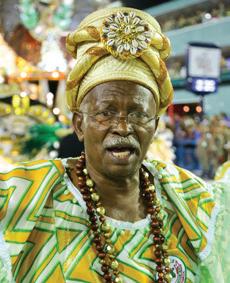

19ª ALA: OMULU – IMPÉRIO DA TIJUCA, “O NEGRO NA CIVILIZAÇÃO BRASILEIRA”, 1969 19TH WING: OMULU – IMPÉRIO DA TIJUCA, “BLACK PEOPLE IN THE BRAZILIAN CIVILIZATION”, 1969 Referência ao desfi le da Império da Tijuca, com uma fantasia em referência ao orixá Omulu numa época em que não era comum a presença de orixás em desfi les de escolas de samba. Reference to the Império da Tijuca parade. João paraded wearing a costume in reference to the orisha-Omulu. At the time, the presence of orishas in parades was not common.
20ª ALA: REALEZA NAGÔ - IMPERATRIZ LEOPOLDINENSE, “OROPA”, FRANÇA E BAHIA, 1970 | 20TH WING: ROYALTY NAGÔ - IMPERATRIZ LEOPOLDINENSE, “UROPE”, FRANCE AND BAHIA”, 1970 (VELHA-GUARDA | HONORARY SENIOR MEMBERS) Refere-se ao desfi le de 1970, quando João da Gomeia interpretou o Rei Nagô. Sua fantasia reforça a brasilidade a partir da colagem de fragmentos literários de autores modernistas. It refers to the 1970 parade, when João da Gomeia played Rei Nagô. His costume reinforces the Brazilianity due to the collage of literary fragments by modernist authors.
DESTAQUE DE CHÃO | FLOOR SPOT: POCAH FANTASIA: TRAÇOS DE PAMPLONA COSTUME: PAMPLONA’S TRACES Os motivos africanos de Pamplona são coerentes com a imagem de João da Gomeia. The Pamplona’s African motifs are in line with João da Gomeia’s image.
4º CARRO: UM SARAVÁ PRA FOLIA 4TH FLOAT: A SALUTE TO THE REVELRY Homenagem à diversidade de Joãozinho, que vestia trajes criados por ele mesmo de múltiplos personagens históricos e dezenas de personalidades. Homage to the diversity of Joãozinho, who wore costumes created by himself from multiple historical characters and dozens of celebrities.
21ª ALA: LEGIÃO DE NOTÁVEIS 21ST WING: NOTABLE LEGION Referência à fama de Joãozinho da Gomeia. Ele atraía muitas personalidades infl uentes para a cidade de Duque de Caxias. | It is a reference to the fame of Joãozinho da Gomeia. He attracted an endless number of infl uential celebrities to the city of Duque de Caxias-Rio de Janeiro.
22ª ALA: PRESIDENTES NO XIRÊ 22ND WING: PRESIDENTS INVOKING THE ORISHAS Referência explícita aos relacionamentos de João da Gomeia com o mundo político brasileiro. | It is an explicit reference to João da Gomeia’s relationships with the Brazilian political universe.
DESTAQUE DE CHÃO | FLOOR SPOT: ADRIANA BOMBOM FANTASIA: TEATRO FOLCLÓRICO BRASILEIRO COSTUME: BRAZILIAN FOLKLORIC THEATER João da Gomeia apadrinha o Teatro Folclórico Brasileiro criado por Haroldo Costa e relacionado ao Teatro Experimental do Negro. João da Gomeia sponsors the Brazilian Folklore Theater created by Haroldo Costa and related to Experimental Black Theater.
23ª ALA: BALÉ AFRO | 23RD WING: AFRO-BALLET Refere-se ao grupo de balé afro de João da Gomeia e suas fi lhas de santo. Desse balé, saiu a primeira bailarina negra do Theatro Municipal do Rio de Janeiro. | It refers to the Afro-ballet group of João da Gomeia and his initiated followers. The fi rst black dancer of the Municipal Theater of Rio de Janeiro was chosen from this ballet.
24ª ALA: COPACABANA MON AMOUR 24TH WING: COPACABANA, MON AMOUR (FILM) A ala traz o artista João da Gomeia integrante do elenco do fi lme Copacabana Mon Amour. | The wing-group brings the artist João da Gomeia from the cast of the fi lm Copacabana Mon Amour. DESTAQUE DE CHÃO | FLOOR SPOT: KAREN LOPES FANTASIA: LINA, A MULHER DE FOGO COSTUME: LINA, THE FIREWOMAN A fantasia se refere ao fi lme “Lina, la mujer de fuego”, com João da Gomeia no elenco. The costume refers to the fi lm “Lina, la mujer de fuego”, with João da Gomeia in the cast.
TRIPÉ: QUEM FAZ SUA GIRA COM FÉ? TRIPOD: IT IS IMPORTANT TO HAVE FAITH IN THE ORISHAS Faz-se referência a uma suposta apresentação de Joãozinho para a então princesa Elizabeth, futura Rainha Elizabeth II. E Faz-se alusão à viagem secreta que levou o Pai de Santo ao canteiro de obras de Brasília, a pedido de JK. | Refers to an alleged presentation Joãozinho made to the then Princess Elizabeth, future Queen Elizabeth II. And alludes to a secret trip that took Joãozinho to the construction sites of the city of Brasilia, as a request of Juscelino Kubitschek.
25ª ALA: CAPOEIRA ANGOLA 25TH WING: ANGOLAN CAPOEIRA João da Gomeia acreditava nas práticas culturais, como a da capoeira Angola. | João da Gomeia encouraged cultural practices, such as that of capoeira Angola.
26ª ALA: SÃO JOÃO NA GOMEIA 26TH WING: JUNE PARTY IN GOMEIA A ala relembra o terreiro da Gomeia que sediou os maiores festejos juninos da cidade. | The winggroup recalls the Gomeia sacred yard that hosted the biggest June festivities in the city.
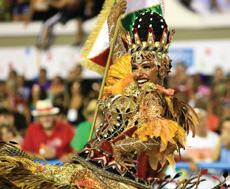
DESTAQUE DE CHÃO | FLOOR SPOT: LUISA SONZA FANTASIA: FESTA POPULAR COSTUME: POPULAR FESTIVITIES Festas juninas e folguedos de reis podem ser observados como representativos da nossa brasilidade. | June festivities and the Revelry of Kings’s day can be seen as representative parties of our Brazilianity.
27ª ALA: FOLIA DE REIS 27TH WING: THE REVELRY OF KINGS’ DAY A ala representa a Folia de Reis. | The group represents the Revelry of Kings’ day, a typical Brazilian festivity.
28ªALA: RAIO DE IANSÃ, VENTO DE MATAMBA 28TH WING: IANSA’S RAY, MATAMBA’S WIND Joãozinho da Gomeia era fi lho de Oxóssi e também de Iansã. Dizem que, em idade madura, Joãozinho passou a se dedicar mais às festas de Iansã. Joãozinho da Gomeia was consecrated to Oshosi, but also to the orisha-Iansa. It has been said that, at a mature age, Joãozinho started to dedicate himself more to the parties of Iansan.
GRUPO DE CASAIS MIRINS | GROUP OF CHILD MASTER-OF-CEREMONIES AND FLAG-BEARERS
FANTASIA: IBEJADA COSTUME: IBEJADA- THE CHILD ENTITIES Os casais relembram Cosme e Damião e a prática festiva que levava a molecada de Caxias ao terreiro da Gomeia. | The couples recall a typical Brazilian religious festivity destined to kids that took place in the Gomeia sacred-yard.
29ª ALA: SEMENTES DO QUILOMBISMO 29TH WING: THE QUILOMBO SEEDS Representa uma espécie de Quilombo atual na Gomeia-Caxias, já que o terreiro transformouse num espaço de sociabilidade, centro de intercâmbio artístico e cultural, refúgio e abrigo para necessitados. | It represents a kind of current Quilombo in Gomeia-Caxias, since the Joãozinho’s sacred-yard has become a space for sociability, a center for artistic and cultural exchange, a refuge and shelter for the needy. 30ª ALA: HERDEIROS DA GOMEIA – POVO DE AXÉ 30TH WING: GOMEIA HEIRS – PEOPLE OF SPIRITUAL VIBRATIONS A última ala veste roupas associadas aos trajes cerimonias do Povo de Axé. | The last wing-group wears clothes associated with the ceremonial garments of the Axé People (followers of AfroBrazilian religions).
DESTAQUE DE CHÃO | FLOOR SPOT: THAINÁ OLIVEIRA FANTASIA: ANDORINHA COSTUME: SWALLOW BIRD Refere-se à história do dia de morte de Joãozinho da Gomeia. Conta-se que havia andorinhas desenhando símbolos sobre o céu do terreiro da Gomeia. | Refers to the story of Joãozinho da Gomeia’s day of death. It is said that there were swallow birds drawing symbols on the sky of the Gomeia sacred yard.
5º CARRO: O REVOAR DA LIBERDADE 5TH FLOAT: THE FLIGHT OF FREEDOM Trata-se de uma celebração da liberdade e da luta contra a intolerância religiosa. O carro conta com a presença de herdeiros da Gomeia marcando a sociabilidade histórica, cultural e de africanidade do Pai de Santo da Gomeia. | It is a celebration of freedom and of the fi ght against religious intolerance. The fl oat takes the heirs of Gomeia representing the historical, cultural and African sociability of the Gomeia spiritual leader (Pai de Santo).
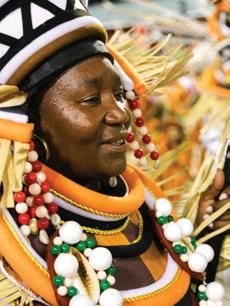

Unidos do Viradouro
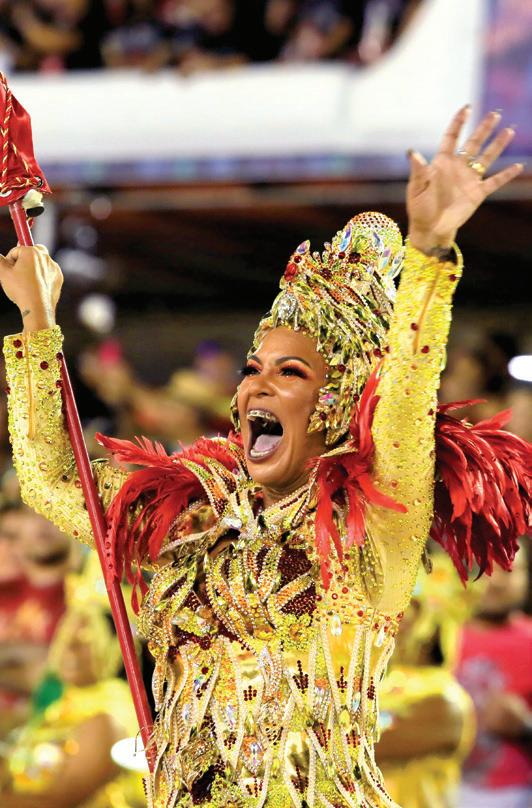



Ficha Técnica | Technical Summary

Enredo | Theme - VIRADOURO DE ALMA LAVADA | VIRADOURO’S CLEANSED SOUL Fundação - 24 de junho de 1946 | Established in June 24th, 1946 Presidente | President - Marcelo Calil Petrus Filho Cores - Vermelho e Branco | Colors - Red and White Carnavalesco | Carnival Designer - Marcus Ferreira e/and Tarcísio Zanon Diretores de Carnaval | Carnival Directors - Alex Fab e/and Dudu Falcão Diretor de Harmonia | Harmony Director - Mauro Amorim






